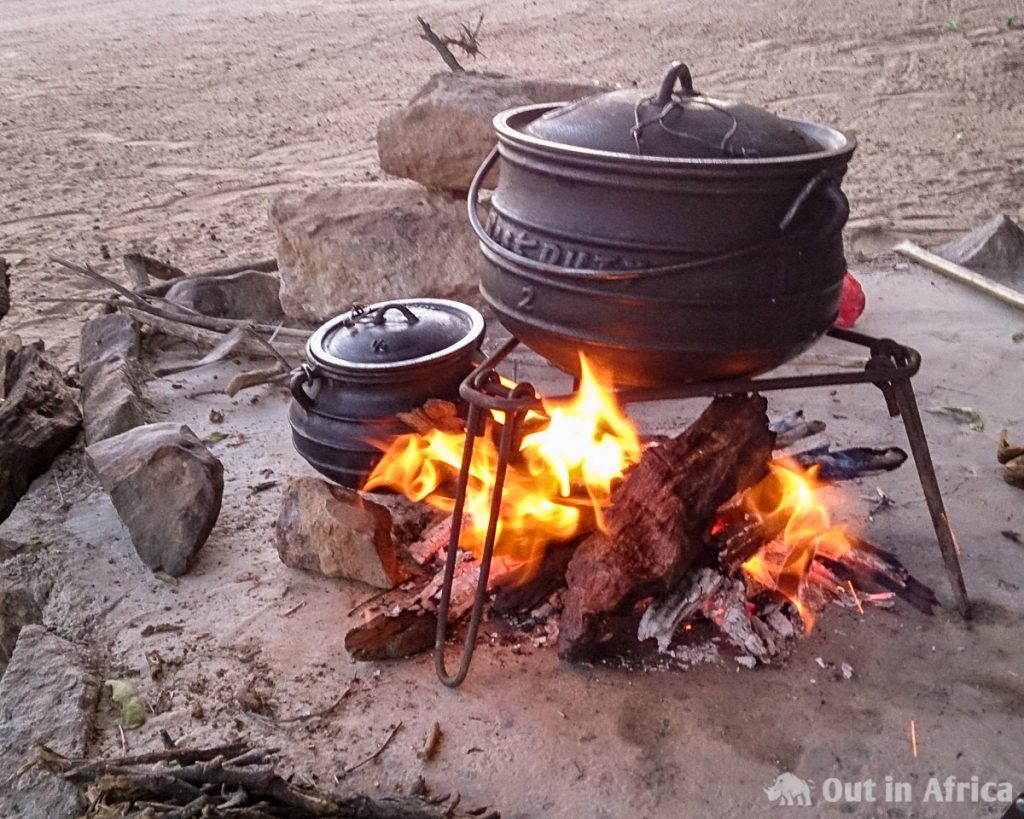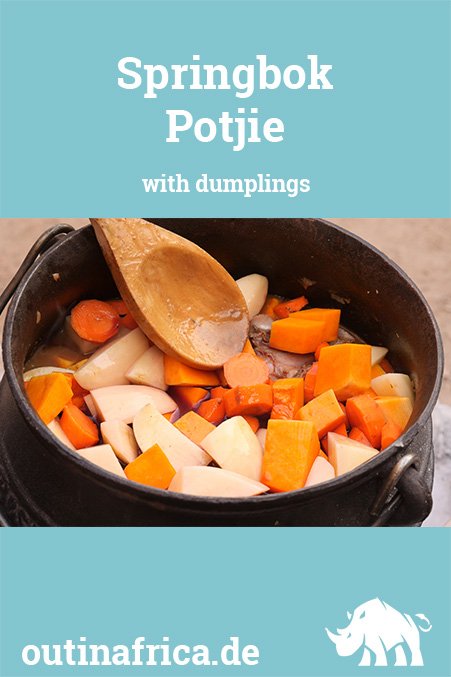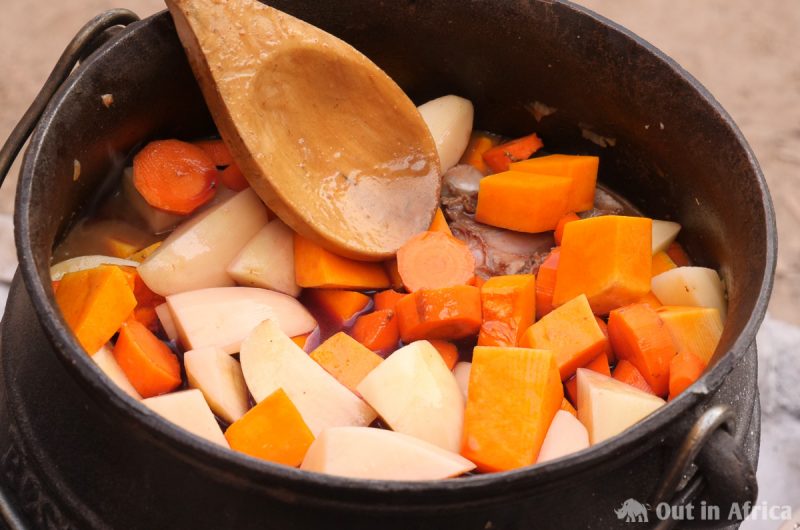This post is also available in:  Deutsch (German)
Deutsch (German)
Have you seen the round, three-legged, cast-iron pots in Southern Africa? Every household has at least one. Maybe you’re wondering what the locals prepare with this pot? One answer is: We cook a potjie. Here we show you what is remarkable about a potjie and how we prepared it.
A short sentence on pronunciation: “Potjie” is an Afrikaans word and if you don’t want to embarrass yourself, say it as the Boers do: Poikie.
What’s a Potjie?

A potjie can be several things:
- A potjie is a three-legged, cast iron pot. Actually “Potjie” is the trivialisation of the word “Pot”, but all three-legged pots, also those with the size 25 (70l), are Potjies.
- A potjie, or more precisely “potjiekos”, is a stew that is prepared in a potjie, i.e. food from a potjie.
- The social get-together when a group of people cook a potjie in a potjie is also a potjie. An invitation sounds like this: “Do you feel like coming over for a potjie on Saturday?” If you accept such an invitation, schedule at least the afternoon and evening, if not the whole day.
The dish is typical “Boerekos”, a dish of the Boers in southern Africa. Jan van Riebeek brought the pot from the Netherlands to the Cape, and the Voortrekkers already cooked their stew in a three-legged pot 200 years ago.
What is Potjiekos made of?
A potjie dish is a stew of meat and vegetables. As far as the ingredients are concerned, there are no limits to the imagination. Be it beef, lamb, chicken or other exotic types of meat – you can turn everything into a potjie. Often offal like tripe is also added to a potjie.
You should make sure that it is a meat that is suitable for a stew, such as an oxtail or stewing meat of beef. If you only have filet or chops in stock, make Braaivleis from them.
A few quite progressive people might also prepare a vegetarian potjie. Whether this is still a real potjie, remains to be seen.
The Voortrekkers, back in the day, had hardly any vegetables with them. They were on their journey with their ox wagons. Vegetable ingredients were sought in the bush.
So real potjie is rather a lot of meat with vegetables.
A lot is possible in the selection of vegetables. Onions, potatoes, carrots and pumpkin are almost always put into a potjie. Mushrooms, cabbage, broccoli, green beans or peas are often used.
A question that is often asked in recipes is the question of quantity. How many grams of meat? How many millilitres of broth? In this respect, a potjie is more a matter of instinct than of science.
A potjie needs a lot of time
Time is very important in the preparation of a potjie. You can’t finish a potjie in an hour. Then you might have a soup or a stew, but no potjie. Potjie is slow food; they are cooked on low heat for several hours.
Critics may object that a potjie cooks too long, that everything is overcooked, and that there are no more vitamins in the final result. If you want your vegetables crisp and rich in vitamins, fry them in a wok or make a salad. A potjie is about extracting and mixing the flavours of the ingredients over a long time and on low heat.
A potjie is a social get-together
The preparation of a Potjies is more than putting ingredients into a pot and heat until it is cooked. Traditionally, potjie is cooked in a company of family and friends. You sit together for several hours, talking, singing, laughing and drinking while the potjie is simmering over the fire.
In the group, one person should be the main chef. The others are allowed to cut vegetables and maybe to taste the potjie, but only one is responsible for cooking.
We cook a potjie
Some time ago, Anita and Heiko prepared a potjie in a potjie during a relaxed weekend at Spitzkoppe. They used Springbok shanks as meat.
Here I give the recipe for the potjie, but you can be flexible in this dish and exchange ingredients or use other spices.
In our video, we cooked for six people.
Equipment for Potjie cooking
Without potjie, there’s no potjie. A potjie MUST be cooked in a three-legged pot.
No, that statement is not entirely true. A potjie MUST be cooked in a traditional bulbous pot, but the pot does not have to have three legs.
These pots are also available without legs, and they are also called Potjie. You may use them as long as you can raise the pot in such a way that it is heated from below. Three stones can be used as leg replacements. There are also collapsible stands that raise the potjie so that you can make fire under it. In the past, the potjies were hung on a chain and suspended above the fire. A very modern development is a chimney for a potjie.
As you can see from in the video, we used a chimney. These devices are built especially for the three-legged pots and are strong enough to support several kilos. However, they are also large and bulky. You can also cook a potjie without a chimney. After all, the Voortrekkers did not have chimneys 200 years ago, but they prepared potjie.
We used barbecue briquettes because they help to regulate the heat better. Like the Voortrekkers 200 years ago, you can use wood or embers. Just make sure the fire doesn’t get too hot. Another possibility is to make the fire a little away from the potjie and put some red-hot coals under the pot from time to time.
The recipe for potjiekos
Springbok-Potjie with dumplings
Difficulty: Medium6
Portionen30
minutes5
hoursIngredients
- Ingredients for a potjie
Onions
Carrots
Butternut
Potatoes
Springbok shanks
One packet of diced bacon
200 ml red wine (or 300 ml)
Oil for browning
Two sachets of instant soup, e.g. Oxtail
Spices
Instant broth
Sun-dried tomatoes
- Ingredients for the dumplings
1 Package Self-raising Flour
Salt
350 ml of water
Dried parsley
Instructions
- Preparation
- Peel the onion and cut into small cubes.
- Peel the carrots and cut them into finger-thick slices.
- Peel the butternut, core it and cut it into larger cubes.
- Peel the potatoes and cut them into larger pieces.
- Soak the sun-dried tomatoes and dice them.
- Dissolve the instant soups in 500 ml hot water. Fill them up with another 500 ml of cold water.
- Cooking
- Before we start cooking, I’d like to say a few words about technique. The lid of the potjie always stays on unless you put ingredients in the pot, stir, taste or look in to see if it’s boiling too much. Otherwise, the pot stays closed.
- When the barbecue briquettes are glowing, or the embers from the fire have heated the pot, add oil to fry in the pot.
- Fry the meat in the hot oil until it is lightly browned on all sides.
- Stir the diced bacon into the meat.
- When the meat is brown, put the onions in the pot and stir them under the meat.
- Put the dissolved soups into the pot and stir well.
- Add the instant broth. Stir.
- Put the sun-dried tomatoes in the pot and stir.
- Let this mixture simmer for a long time on low to medium heat. The Boers say that the contents of the pot must “speak”, but must not speak too loudly. Do not boil it aggressively, but only quietly. On the video, our Potjie speaks almost too loud.
- When the meat is almost cooked (which should not happen too fast), add the vegetables.
- Add the wine.
- Now the traditions are diverging. Some insist that a potjie may no longer be stirred. They put first the hard vegetables, which need longer, into the pot and later the softer vegetables. Each ingredient should keep its taste.
Others continue to stir in the pot to allow the taste of the meat to mix with that of the vegetables. The purists call this “stew” rather than potjie.
Mix the self-raising flour, salt, dried parsley and water to make a soft dough. - When all the contents in the pot are soft, taste it again.
- Make the dumplings
- Mix the self-raising flour, salt, dried parsley and water to make a soft dough.
- Then put the dumpling dough on top of the stew by the spoonful. Surprisingly, the dough does not dissolve into the stew but forms dumplings which are steamed from below by the stew.
- Place a few glowing coals on the lid of the potjie so that the dumplings also get a little top heat. However, they should not develop a crust but remain soft.
- When the dumplings are done (no more dough sticking to the fork when you push it in and they have a bread-like consistency), the potjie is ready.
- Now you can place the potjie on plates. The trick is to scoop through all the ingredients with a big spoon, so everyone gets some of everything. Everyone gets a dumpling, which serves as bread for the stew.
Recipe Video
Bon appetit.
If you enjoy Potjie cooking, try other meats and vegetables. If you are really good, you can take part in a Potjiekoskompetisie, a competition that is held in every small South African town.
More information about the Potjie
If you are interested in the potjie (pot and dish) history, I recommend you
- The article „Potjiekos“ from the Namibian (in English).
- The Wikipedia entry „Potjiekos“ (German) and „Potjiekos“ (English)
- A brief history of the cast-iron potjie pot (English)
- Potjiekos (Afrikaans)
Do you also want to cook a potjie?
Do you fancy Potjiekos? What would you use for cooking it? Have you eaten Potjiekos yet? Did you like it?
Write to us about your experiences and plans in the comments.

Anette Seiler




How long must a Springbok shank potjie take over the coals ?